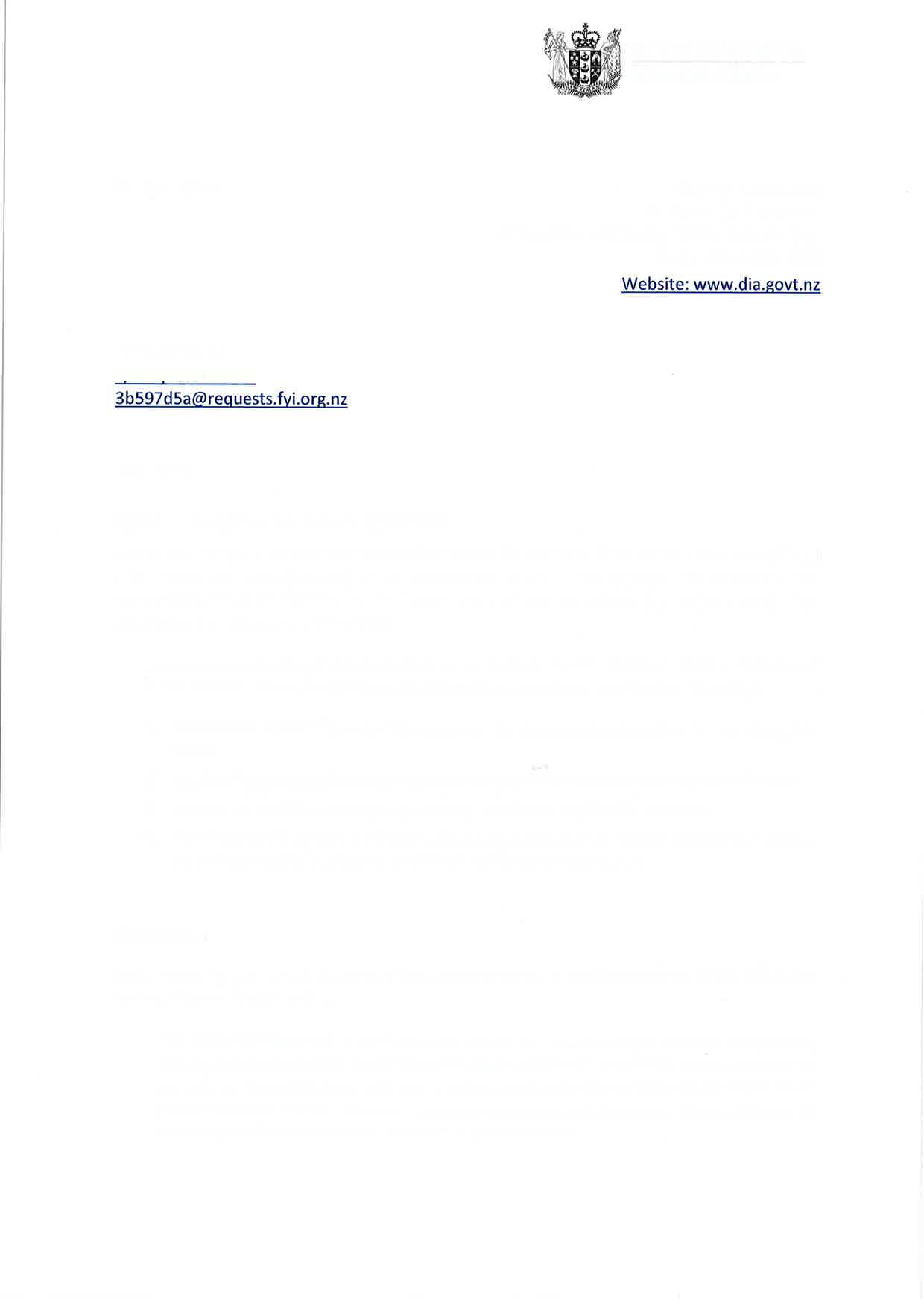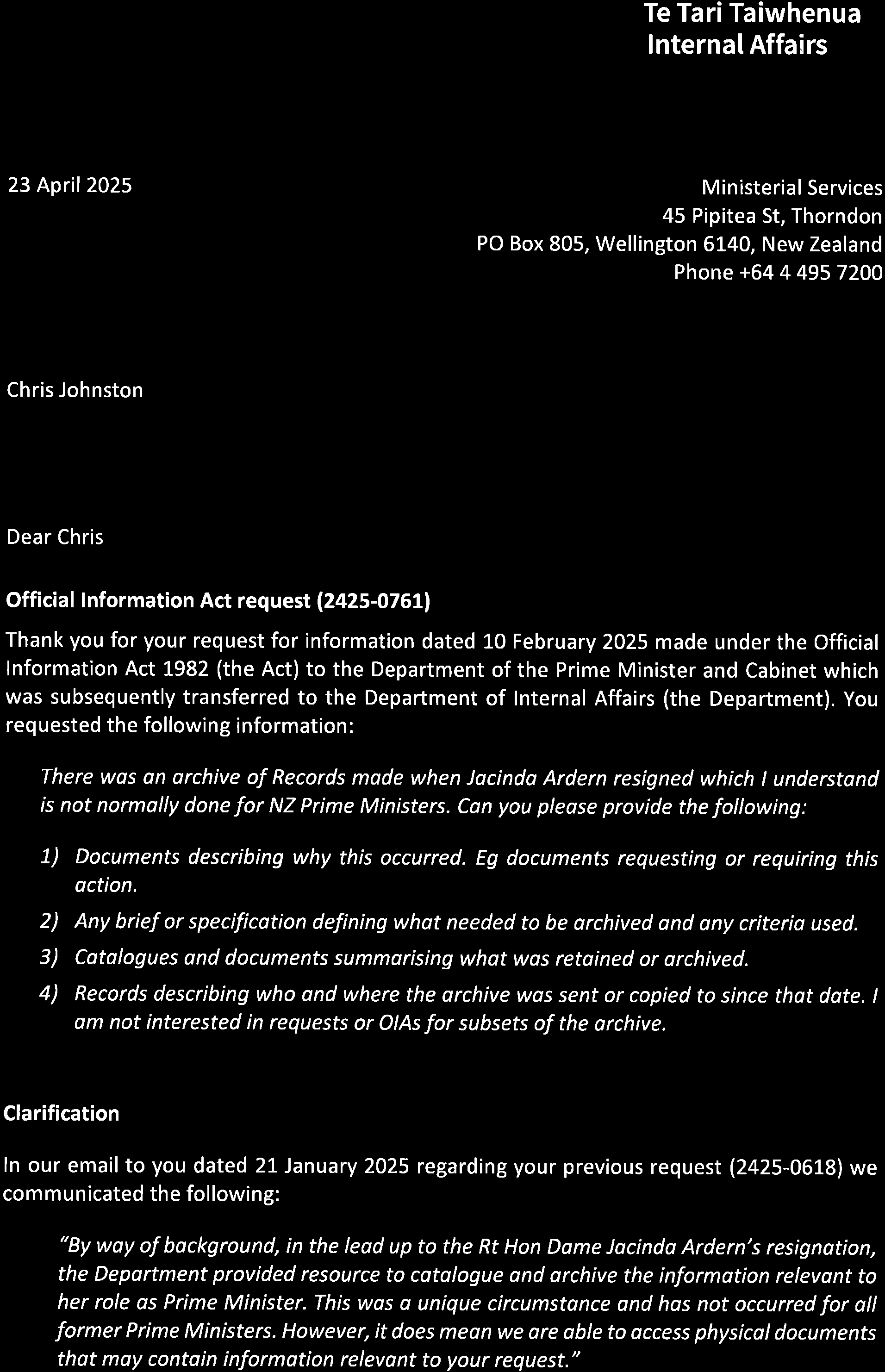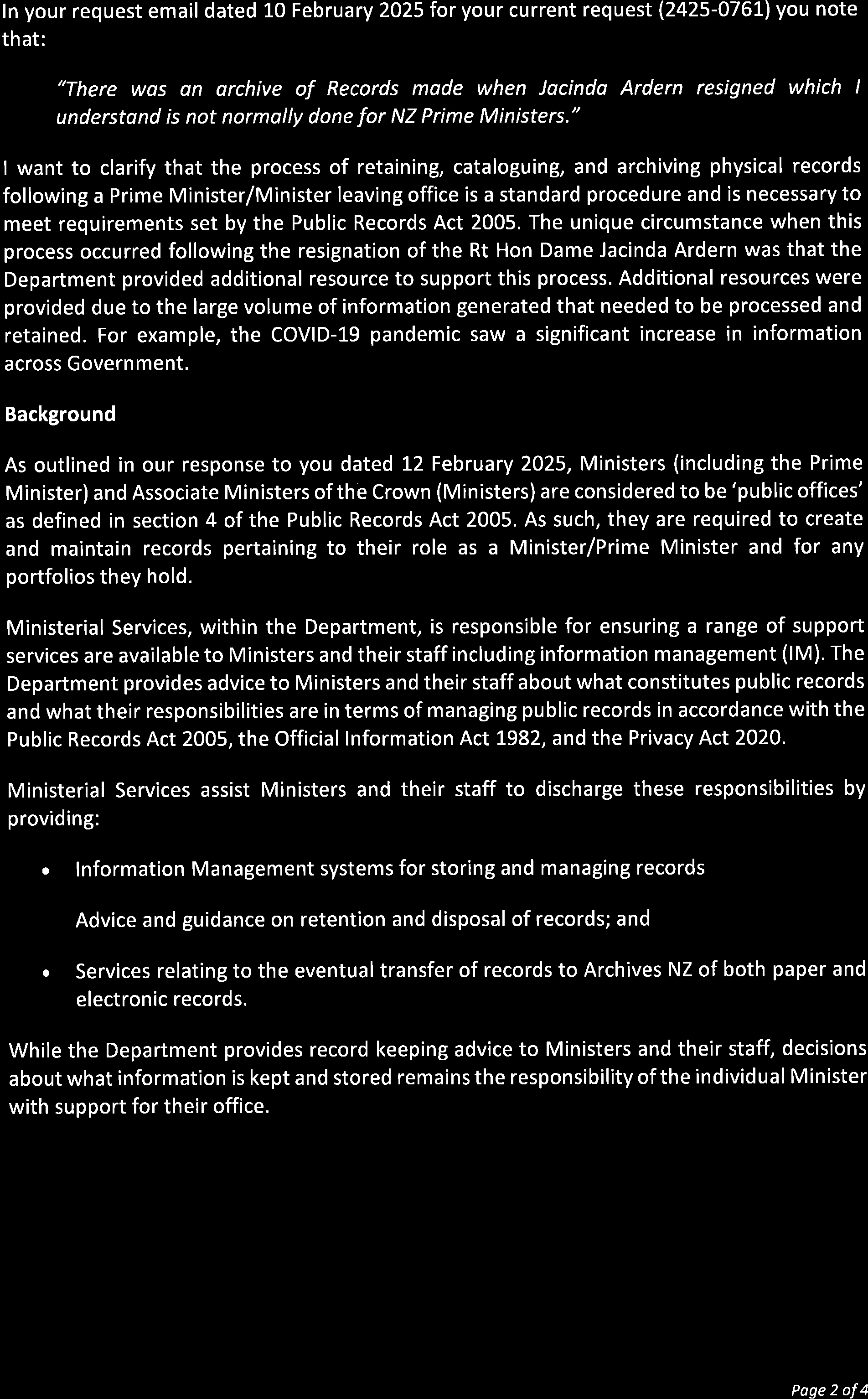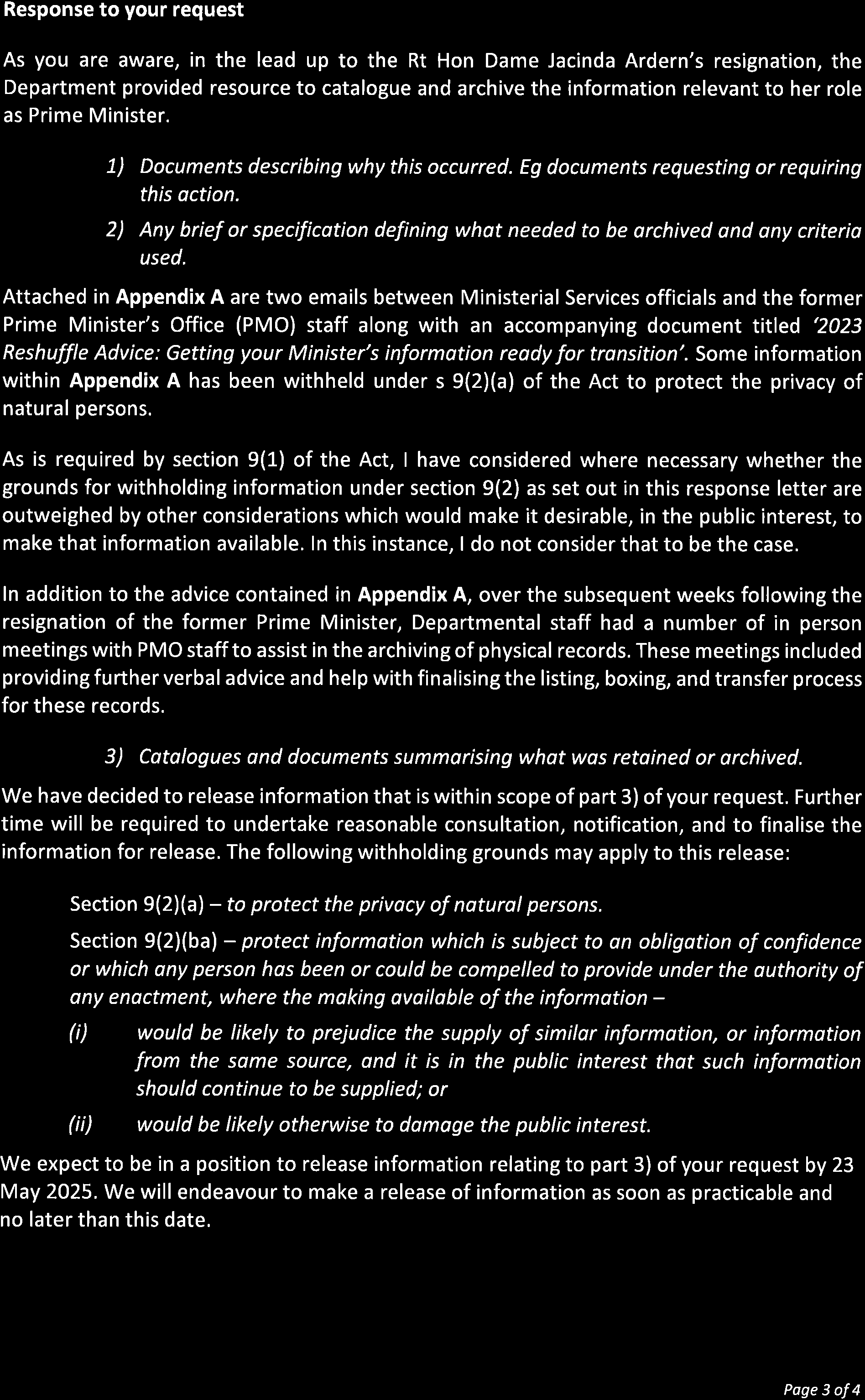












Appendix A
From:
Olwyn Crutchley
To:
"Olwyn Crutchley"
Subject:
FW: IM Getting your Ministers information ready for transition 2023
Date:
Tuesday, 31 January 2023 3:31:38 pm
Attachments:
IM Getting your Ministers information ready for transition 2023.docx
image001.png
From: Olwyn Crutchley
Sent: Tuesday, 31 January 2023 3:31 pm
To: 9(2)(a)
Cc: Ainsley Chapman ; Melanie Wilson ; Dinah Okeby ; Lucy Gleeson
Subject: IM Getting your Ministers information ready for transition 2023
Kia Ora 9(2)(a)
I understand that you would like some advice on the approach to sorting the Hon Jacinda
Ardern’s records. I have attached an updated guidance document that I hope will answer most
of your questions.
The process is slightly complicated at present because the Disposal Authority which would cover
Prime Ministerial records is still going through review by Archives New Zealand and will not be
formally signed off until April/May. We have covered this off with the suggestion that you use
the Authority as guidance to mark material for deletion, but we will not be able to delete it
legally until the Authority is in place. This is also the position for Ministerial records in hard-copy.
If you would like assistance with this process or have questions as you start to look at the
material Melanie Wilson, Senior Information Advisor, or myself are very happy to come over and
work through this with you. If you require boxes for offsite storage please let Melanie know and
we will arrange for some to be delivered (note this may have some lead-time if more than a few
are required)
Please don’t hesitate to ask us anything, as this can seem a bit complicated if you have not had
to do it before.
Regards
Olwyn
Olwyn Crutchley (She/Her) | Director Information Management |
Ministerial Services|Te Haumi
The Department of Internal Affairs Te Tari Taiwhenua
Tel: 04 4748151 | Mob: 9(2)(a)
45 Pipitea St | PO Box 805, Wellington 6140, New Zealand | www.dia.govt.nz
Logo-test
under the Official Information Act 1982
Released
 UNCLASSIFIED
UNCLASSIFIED
1982
2023 Reshuffle Advice:
Act
Getting your Minister’s information
ready for transition
Information
A guide for Senior Private Secretaries
Official
the
under
Released
Version date: January 2023
Ministerial Resourcing
Ministerial Services
UNCLASSIFIED
Contents
SECTION 1 - Introduction ........................................................................................... 3
What you need to consider ........................................................................................ 3
What the Public Records Act requires ....................................................................... 3
What you need to do ................................................................................................. 4
SECTION 2 – Action plan ............................................................................................ 4
Step 1: Initial preparations – consider and identify ................................................... 4
1982
Step 2: Categorise and move ..................................................................................... 5
TABLE 1: INFORMATION TO KEEP FOR SUBSEQUENT TRANSFER TO ARCHIVES
Act
NEW ZEALAND .................................................................................................. 5
TABLE 2: INFORMATION TO MARK FOR FUTURE DELETION ............................ 6
TABLE 3: INFORMATION TO DESTROY .............................................................. 7
Step 3: List physical information ................................................................................ 8
Step 4: Box physical information ............................................................................... 9
Step 5: Destroy information ....................................................................................... 9
Appendix A – Frequently Asked Questions .............................................................. 10
Why does it matter? .......................................................................................
Information 10
What happens to the information once a Minister moves on? ..................... 10
What happens to the drives and folders the Minister and their office staff
have been using? ............................................................................................ 10
How long does a Minister’s information need to be kept? What is a disposal
authority? ....................................................................................................... 11
Official
Appendix B – Ministerial Records Listing Schedule Template ................................... 12
the
Appendix C – Draft Disposal Schedule for Ministers’ Records .................................. 12
under
Released
UNCLASSIFIED
Page 2 of 12
UNCLASSIFIED
SECTION 1 - Introduction
Ministers’ information needs to be appropriately managed at all times in the lead up to, and
following, the General Election and during transitions between offices.
As a Senior Private Secretary (SPS) you will need to determine what information can be
deleted or destroyed, and what needs to be kept and stored. Your Minister wil need to be
involved in some of these decisions.
1982
This guide wil help you to support your Minister to meet their obligations under the Public
Records Act 2005 (PRA), Privacy Act 2020 and Official Information Act 1982 (OIA) and Act
outlines the steps you wil need to follow. Additional guidance is available if you need it -
please contact your Portfolio Manager in the first instance.
Your goal is to have your Minister’s information in a ready state at all times, so that you and
your Minister are well prepared for any transition period. Please note
information and
records are used interchangeably in this guide. The guide also refers to
Destroy. Destroy
covers both the
destruction of physical information and the
deletion of digital information.
What you need to consider
Information
Ministers have multiple roles. In addition to being part of the Executive, they are also a
Member of Parliament, party member and private citizen.
Information your Minister (and their office) receives or creates in their Ministerial capacity is
covered by the PRA, Privacy Act and OIA. There are specific requirements that need to be
Official
met. Your Minister is personally responsible for meeting these obligations.
Information your Minister receives in their capacity as a Member of Parliament, party
the
member or private citizen is not subject to the PRA or OIA. The Minister can decide what
happens to this information. Where this information contains personal information about
others, the Minister is stil subject to the Privacy Act.
What the Public Recor
under
ds Act requires
The PRA defines a public record as ‘any information that is created or received by a public
office in the conduct of its affairs’. The Act requires that Ministers:
• Create full and accurate records in accordance with normal, prudent business
practice, and organise and maintain them in accessible form for as long as they are
required; and
Released
• Dispose of these records legally and appropriately when no longer required. The
disposal of records must be authorised by the Chief Archivist via a Disposal Authority,
and usually entails either destruction or transfer to Archives New Zealand.
UNCLASSIFIED
Page 3 of 12
UNCLASSIFIED
Note:
Disposal authorities are approved by the Chief Archivist. There are different disposal
authorities covering different classes (categories) of information. The tables within Section 2
below will act as a guide and are based on the Ministers’ Disposal Authority, which is
currently being consulted on, as well as the applicable General Disposal Authorities that
apply to all public records. If you require detailed guidance, Information Management staff
are available to assist you, please talk to your Portfolio Manager in the first instance.
1982
What you need to do
1.
Consider what information is held by you and your staff and where the information
Act
currently resides.
2.
Identify,
in consultation with your Minister, what action needs to be taken with that
information in accordance with the instructions provided,
e.g., destroy, store, transfer to
a new Minister or return to the originating agency.
3.
Categorise the information based on the instructions provided, i.e., create folders or files
and
move content to the appropriate new location.
4.
Box-up physical (paper) information which needs to be stored. Include a contents list
Information
created using the supplied template – see Appendix B.
5.
Destroy information which does not need to be kept.
Official
SECTION 2 – Action plan
the
Step 1: Initial preparations – consider and identify
Identify al the information held in your office, including on people’s work phones, on shared
(K) or personal drives, in email accounts, social media and messaging apps, or stored in
under
cabinets and cupboards etc.
Ask staff in your office to tidy up their personal drives and email accounts in preparation for
the next step:
• Delete any duplicated information (including print outs of digital information).
• Move any portfolio or other official information stored in staff personal drives to the
shared (K) drive.
Released
• Using the two “Information to keep” tables below as a guide, make file notes of any
significant information that needs to be recorded from text messages, social media,
voicemails etc., and save them in the shared (K) drive.
UNCLASSIFIED
Page 4 of 12

1982
Act
Information
Official
the
under
Released

1982
Act
Information
Official
the
under
Released

1982
Act
Information
Official
the
under
Released

1982
Act
Information
Official
the
under
Released
UNCLASSIFIED
Step 4: Box physical information
Physical information that has been categorised and listed need to be placed in boxes:
1. Order boxes from DIA for storage (contact Ministerial Resourcing for these).
2. Place the files/folder in the box in the same order as the listing spreadsheet.
3. Files/folders should fit comfortably so they can be easily removed if access is
required.
1982
4. Write the Minister’s name and a number on the lid of each box, labelling them Box 1
of xx, 2 of xx, 3 of xx etc and add this number to the listing spreadsheet.
5. Secure a copy of the listing schedule inside the box to the underside of the lid, to be
Act
able to read the list easily if access to the box is required.
6. Send a digital copy of the listing spreadsheet to the Ministerial Resourcing team.
Please note these boxes will go into storage. Information and records described in Table 1
will later be transferred to Archives New Zealand. If your Minister thinks that particular
access restrictions are appropriate for groups of this information, please consult with
Information Management staff about this aspect.
Information described in Table 2 will be stored until they have reached their minimum
retention period, after which they wil be destroyed.
Information
Step 5: Destroy information
When disposing of physical information that can be destroyed immediately (e.g. print outs
and copies):
Official
• For information classified SENSITIVE or RESTRICTED, or above, use the NZSIS
approved shredder (grade 3) in your office.
the
• Information classified as UNCLASSIFIED or IN-CONFIDENCE, should be disposed of in
the secure bin in your office.
under
Released
UNCLASSIFIED
Page 9 of 12
UNCLASSIFIED
Appendix A – Frequently Asked Questions
Why does it matter?
Information from Ministers’ offices forms part of the public record, as well as capturing a
Minister’s legacy and their part in the history of New Zealand. This information tells us what,
where, when and why business activities occurred. It shows the context of decisions and
under what authority they were made, and provides evidence of Government and public
1982
office business activity.
The PRA requires Ministers, in simple terms, to keep a record of their advice, actions and
Act
decisions. It doesn’t matter how this information has been communicated, e.g.., by text,
email, social media, paper etc., the important thing is that the information needs to be
captured and managed appropriately.
What happens to the information once a Minister moves on?
Ministers have discretion over what information is passed to their successor. They may
choose to make some, or all, of this information available. Ministerial Services will generally
facilitate any information transfer.
Information
In the case of a change in Government following an election, information created or received
by the previous Government may be made available to the Government of the day at the
Ministers’ discretion.
What happens to the drives and folders the Minister and their office staff
Official
have been using?
As a general rule:
the
•
Ministerial staff will lose access to the Minister’s (K) Drive and Ministerial Outlook
folders when they no longer work for that Minister, or when a Minister of former
Minister departs Parliament, or when their Minister is no longer a Minister.
•
Ministers will retain access to their personal H drive, their shared (K) Drive and
under
their Ministerial Outlook folders until such time as they leave Parliament.
•
Ministers and their staff will continue to have access to their own personal drive
for as long as they are in Parliament.
The outgoing Minister can approve a copy of Portfolio related information to be passed to
their successor. They retain the original information.
Released
UNCLASSIFIED
Page 10 of 12
UNCLASSIFIED
How long does a Minister’s information need to be kept? What is a disposal
authority?
This is determined by a set of rules set out in a disposal authority, which is issued by the
Chief Archivist. A disposal authority lists the different categories of information which
Ministers are likely to create or receive in their role, how long this information needs to be
kept for, and what happens to it after a specified period.
For information that can be destroyed, each office can decide how long it needs to be kept. 1982
Offices should consider factors such as their Minister’s preferences and how likely it is that
the information will need to be referred to again. The ministerial information that needs to
be retained will initially be stored for at least five years, then may be deposited with Act
Archives New Zealand.
Any special conditions relating to public access to these records must be agreed at time of
deposit. This is done by means of an access authority and wil be facilitated by Ministerial
Services and Archives New Zealand.
Draft Disposal Schedule for Ministers’ records (not yet authorised) (see Appendix C)
See also Archives New Zealand advice on General Disposal Authorities: General disposal
authorities – Archives New Zealand
Information
Official
the
under
Released
UNCLASSIFIED
Page 11 of 12

 UNCLASSIFIED
Appendix B – Ministerial Records Listing
Schedule Template
UNCLASSIFIED
Appendix B – Ministerial Records Listing
Schedule Template
Ministerial Records
Listing Schedule Temp
1982
Appendix C – Draft Disposal Schedule for
Act
Ministers’ Records
ANZ submission -
Draft Disposal Schedu
Information
Official
the
under
Released
UNCLASSIFIED
Page 12 of 12
 From:
From:
9(2)(a)
To:
Olwyn Crutchley
Cc:
Ainsley Chapman
Subject:
RE: Transfer Process
Date:
Wednesday, 12 April 2023 4:48:01 pm
Attachments:
image001.png
Thanks Olwyn, much appreciated.
From: Olwyn Crutchley [mailto:[email address]]
Sent: Wednesday, 12 April 2023 4:38 PM
To: 9(2)(a)
1982
Cc: Ainsley Chapman DIA
Subject: Transfer Process
Kia ora 9(2)(a)
Act
As discussed, the records will initially go into offsite storage for a period of 5+ years. During this
time they are considered as Former Ministers Records and any requests (OIA or the like) would
come in via the Ministerial Services team and will be discussed with the Rt Hon Ardern. Nothing
would be released without her say-so.
In the longer term Transfer to Archives New Zealand is governed by their process: Transfer
process – Archives New Zealand
In essence the Department would initiate this when the records reach the timeframes in the
Disposal Authority. We would work with the former Prime Minister on the transfer, in
conjunction with Archives NZ. Future access provisions and restrictions are negotiated as part of
Information
the transfer process with the owner of the records (in this case the Rt Hon Ardern is considered
the regulated organisation and DIA would facilitate the process):
Access decisions
All public records 25 years or older must be classified as either open access or restricted
access, regardless of where the records are held. If the records are transferred to us before
the 25-year limit, their access status must be declared as part of the transfer requirement.
Official
Records that are more sensitive may have a longer period as closed records and more restrictive
provisions applied. As I suggested it would be good for the former Prime Minister to consider
that now, while her memory is fresh. Equally we could just work through that at the point of
the
transfer.
Once you have some listing completed I can get the DIA team to come back and check that we
are on the right track. Once it is all done, they need to seal the boxes and arrange for uplift to
storage. That may need to happen after next Friday, depending on how quickly the listing is
completed, but Ainsley can make sure the room is secure and that only that team access it while
under
that is happening.
I hope this answers your questions.
Regards
Olwyn
Olwyn Crutchley (She/Her) | Director Information Management |
Ministerial Services|Te Haumi
The Department of Internal Affairs Te Tari Taiwhenua
Released
Tel: 04 4748151 | Mob: 9(2)(a)
45 Pipitea St | PO Box 805, Wellington 6140, New Zealand | www.dia.govt.nz
Logo-test
Document Outline




















